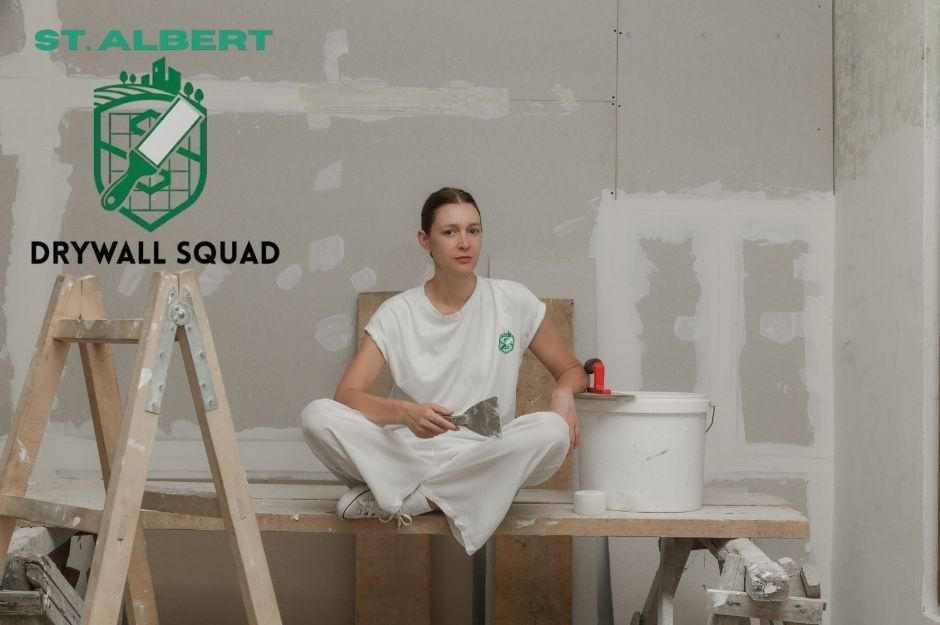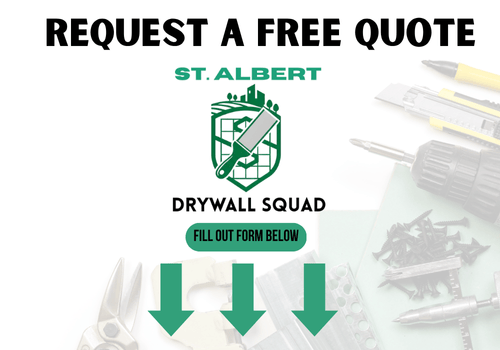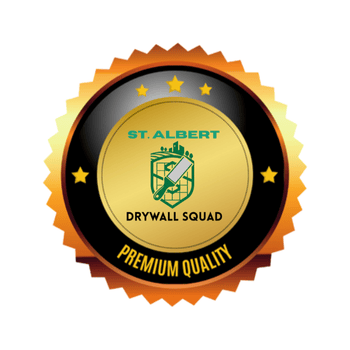Leduc Drywall Repair
Expert Drywall Repair Company in Leduc, Alberta

Finding reliable drywall repair contractors in Leduc, Alberta requires understanding what services are available and how to choose the right professional for your project. Professional drywall contractors at St. Albert Drywall Squad in Leduc provide repair services for holes, cracks, water damage, and popcorn ceiling removal, along with complete installation and finishing work.

St. Albert Drywall Squad (CP)

These services address common issues like nail pops, dents from furniture, and damage from plumbing or electrical work that can make rooms look worn and neglected.
Whether you're dealing with minor wall damage or planning a complete renovation, local contractors offer comprehensive solutions for residential and commercial properties in this city of over 34,000 residents located just 33 km south of Edmonton.
Given Leduc's humid continental climate with temperature extremes ranging from -48.3°C in winter to 35.6°C in summer, seasonal expansion and contraction can cause additional stress on drywall surfaces, making professional repairs particularly important.
Understanding your options for repair versus replacement, along with typical costs and contractor qualifications, helps ensure you make informed decisions for your home improvement needs. The right contractor will assess your specific situation and recommend the most cost-effective approach to restore your walls and ceilings.
Drywall Repair Services in Leduc, Alberta
Professional drywall repair services in Leduc handle everything from minor wall patches to extensive water damage restoration. Local contractors specialize in crack repair, hole patching, ceiling restoration, and texture removal to restore your walls to pristine condition. Serving both the historic downtown area near Telford Lake and newer developments throughout the city, these professionals understand the unique challenges of homes built across Leduc's 132-year history since its 1891 establishment.
Patching Walls and Ceilings
Wall repair services in Leduc address various surface imperfections that develop over time. You'll find contractors who handle small nail holes, larger anchor damage, and dents from furniture or accidents.
Professional patching involves cutting out damaged sections and installing new drywall pieces. The repair area gets taped, mudded, and sanded smooth to match the surrounding surface. This process typically requires multiple coats of joint compound.
Common patch repair types include:
- Small nail holes and pin marks
- Screw anchor damage
- Door handle impacts
- Furniture dents and scratches
- Electrical outlet modifications
Ceiling patching follows similar techniques but requires additional support considerations. Your contractor will ensure proper backing material installation before applying the patch. The finished repair should blend seamlessly with your existing ceiling texture.
Repairing Cracks and Holes
Drywall cracks appear due to house settling, temperature changes, or structural movement. You'll notice hairline cracks along seams or larger gaps that require immediate attention to prevent further damage. In Leduc's climate, where annual temperature swings exceed 80°C between winter lows and summer highs, thermal expansion and contraction commonly cause settlement cracks, particularly in older homes from the city's early 20th-century development period.
Small cracks get filled with mesh tape and joint compound. Larger separations may need complete seam reconstruction. Your contractor will determine whether the crack indicates structural issues requiring additional repairs.
Hole repair methods vary by size:
- Small holes (under 1 inch): Mesh patches with compound
- Medium holes (1-6 inches): Self-adhesive patches or backing material
- Large holes (over 6 inches): Cut-out sections with new drywall pieces
Professional drywall repair services use specialized tools and materials for lasting results. The repair process includes priming and texture matching to ensure invisible repairs.
Water Damage Restoration
Water damage creates serious drywall problems requiring immediate professional intervention. You'll need assessment of moisture penetration, mold potential, and structural integrity before repairs begin. With Leduc receiving an average of 434mm of annual precipitation, including 87.2mm during the peak July rainfall period, water intrusion from roof leaks, basement flooding, and plumbing failures represents one of the most common drywall repair needs in the area.
Damaged sections must be completely removed and replaced rather than patched. Your contractor will cut out affected areas extending beyond visible damage to ensure all compromised material gets eliminated.
The restoration process includes moisture testing, antimicrobial treatment, and proper ventilation during drying. New drywall installation follows once the area reaches acceptable moisture levels. Professional contractors in Leduc must account for the city's 56.8% average relative humidity when determining proper drying times and moisture-resistant material selection.
Water damage repair steps:
- Moisture assessment and documentation
- Damaged material removal
- Structural drying and treatment
- New drywall installation
- Finishing and texture matching
Professional water damage restoration prevents future mold growth and ensures structural soundness. Your contractor should provide moisture readings and completion certificates.
Ceiling and Popcorn Texture Removal
Popcorn ceiling removal requires specialized equipment and safety precautions due to potential asbestos content in older installations. You should have pre-1980 ceilings tested before beginning removal work. Many homes built during Leduc's significant growth period following the historic February 13, 1947 Leduc No. 1 oil discovery may contain asbestos in their ceiling textures, making professional testing essential before any removal work begins.
The removal process involves spraying sections with water, scraping off texture, and preparing the surface for new finishes. Professional contractors use plastic sheeting and proper ventilation to contain debris and dust.
After texture removal, your ceiling needs repairs for any gouges or imperfections. The surface gets primed and finished with your chosen texture or left smooth. Modern alternatives include knockdown, orange peel, or smooth finishes.
Texture removal considerations:
- Asbestos testing for pre-1980 installations
- Dust containment and proper ventilation
- Surface preparation after scraping
- Primer application before new finishes
Professional removal ensures safe handling of potentially hazardous materials and proper surface preparation for long-lasting results.
Professional Drywall Installation
Professional drywall installation involves systematic material selection, precise measurement techniques, and specialized finishing methods to create seamless wall and ceiling surfaces. Contractors follow established processes for residential projects while offering customized solutions for unique spatial requirements. Serving Leduc's diverse housing stock—from heritage homes in the original Telford's Place settlement area to modern developments near the city's 35 km network of multiuse pathways—contractors must adapt installation techniques to varied architectural styles.
Residential Drywall Installation Process
Professional contractors begin with accurate measurements and structural assessments. They examine existing framing to ensure proper spacing and identify any repairs needed before installation.
Installation Steps:
- Frame inspection and preparation
- Drywall cutting and fitting
- Securing panels with appropriate fasteners
- Joint taping and compound application
- Sanding and surface preparation
Your contractor will hang drywall sheets systematically, starting from the ceiling and working downward. They position panels to minimize joints and reduce finishing work.
Proper fastener spacing prevents future cracking. Screws are placed every 12 inches along studs and 8 inches along edges. In Leduc's climate, where winter temperatures can plunge to -48.3°C with wind chills reaching -61.1, proper fastener placement and material expansion allowances are critical to prevent seasonal cracking.
The finishing process requires multiple compound coats. Each layer is applied, dried, and sanded before the next application.
Material Selection and Preparation
Standard drywall comes in various thicknesses and types for different applications. Your contractor selects materials based on room function and local building codes.
Common Drywall Types:
- Regular drywall: Standard interior walls
- Moisture-resistant: Bathrooms and kitchens
- Fire-resistant: Garages and furnace rooms
- Soundproof: Bedrooms and media rooms
Panel thickness affects durability and sound transmission. Half-inch drywall suits most residential applications, while five-eighths-inch provides enhanced fire resistance.
Contractors calculate material quantities precisely to minimize waste. They account for door and window openings, ceiling heights, and room configurations. For homes near recreational areas like Telford Lake, Saunders Lake, or Alexandra Park Ponds, contractors often recommend moisture-resistant materials for basements and lower levels prone to humidity from nearby water features.
Quality joint compound and tape ensure long-lasting seams. Paper tape works best for flat joints, while mesh tape suits corners and repairs.
Custom Solutions for New Spaces
Professional installation adapts to unique architectural features and special requirements. Contractors handle curved walls, vaulted ceilings, and irregular spaces with specialized techniques.
Custom Applications:
- Curved and radius walls
- Cathedral ceiling installation
- Built-in storage integration
- Archway construction
Your contractor may recommend specific drywall types for challenging areas. Flexible drywall bends around curves, while lightweight panels suit overhead installations.
Complex projects require advanced measuring and cutting techniques. Contractors use templates and specialized tools for precision fitting.
Installation in renovated spaces often involves matching existing textures and finishes. Experienced contractors blend new work seamlessly with surrounding surfaces.
Timing coordination with other trades ensures efficient project completion. Your drywall installation aligns with electrical, plumbing, and HVAC work schedules.
Comprehensive Drywall Finishing Solutions
Professional drywall finishing transforms rough installations into smooth, paint-ready surfaces through precise taping, mudding, and surface preparation techniques. Quality finishing work ensures your walls achieve a flawless appearance that enhances your property's overall aesthetic appeal.
Taping and Mudding Techniques
Proper taping forms the foundation of quality drywall finishing. Your contractor applies paper or mesh tape along all seams and joints to prevent cracking over time.
The mudding process involves multiple coats of joint compound. The first coat embeds the tape and fills the seam. Second and third coats feather the edges to create seamless transitions.
Essential mudding steps include:
- Base coat application over tape
- Skim coat for smoothness
- Feathering edges 6-8 inches wide
- Complete drying between coats
Corner beads require special attention during finishing. Metal or plastic beads protect outside corners from damage while providing clean, straight lines.
Skilled contractors sand between coats to eliminate ridges and imperfections. This preparation ensures your final surface accepts paint evenly without visible seams or texture variations. During Leduc's dry winter months, when relative humidity can drop below 40%, contractors must carefully control drying times to prevent compound cracking and ensure optimal adhesion.
Smooth and Textured Surface Finishes
Smooth finishes require careful attention to detail during the mudding process. Your contractor applies thin, even coats and sands thoroughly to eliminate any surface irregularities.
Level 5 finishes represent the highest quality smooth surface. This involves applying a skim coat of compound over the entire wall surface, not just seams and fasteners.
Common texture options include:
- Orange peel (light spray texture)
- Knockdown (flattened peaks)
- Skip trowel (hand-applied patterns)
- Popcorn ceiling removal and retexturing
Textured finishes can hide minor imperfections while adding visual interest to your walls. Your contractor matches existing textures when performing drywall repair services in specific areas.
Spray textures provide consistent coverage across large surfaces. Hand-applied textures offer more artistic control but require skilled application techniques.
Priming and Painting for Lasting Results
Quality primer seals the drywall surface and ensures uniform paint absorption. Unprimed drywall creates uneven sheen and color variations that compromise your final appearance.
PVA primers work best on new drywall installations. These primers seal the porous surface and prevent the topcoat from soaking into the material unevenly.
Proper preparation includes:
- Light sanding of any remaining imperfections
- Dust removal with tack cloth
- Primer application with appropriate tools
- Two coats of quality paint
Wall repair services often require spot priming of patched areas. Your contractor feathers the primer beyond repair boundaries to prevent visible patches through the final paint coat.
Professional painters use proper brush and roller techniques to achieve consistent coverage. Quality tools and materials ensure your finished walls maintain their appearance for years without premature wear or fading.
Understanding Costs and Choosing a Contractor
Drywall repair costs vary based on damage type and project scope, while selecting the right contractor requires evaluating experience, credentials, and customer feedback. Quality guarantees protect your investment and ensure lasting results.
Factors Affecting Drywall Repair Cost
Size and complexity determine the base cost of your drywall repair project. Small holes typically cost $50-150, while larger patches can range $200-400 per repair.
Damage type significantly impacts pricing. Water damage repairs cost more due to potential mold remediation and structural concerns.
Popcorn ceiling removal adds complexity and increases labor time. The process requires specialized equipment and safety measures for potential asbestos.
Labor rates in Leduc typically range $50-70 per hour. Material costs add $10-30 per square foot depending on drywall thickness and finish requirements. As part of the Edmonton Metropolitan Region, Leduc's pricing generally reflects regional standards while remaining competitive with Edmonton contractors who service the area.
Multiple repairs often reduce per-unit costs. Contractors may offer volume discounts for addressing several issues during one visit.
Emergency repairs command premium pricing. Weekend or after-hours service can increase costs by 25-50% above standard rates.
How to Select Reliable Drywall Contractors
Verify licensing and insurance before hiring any contractor. Alberta requires proper business registration and liability coverage for professional services. Following the 2023 class action settlement involving 155 former city employees, Leduc residents have become increasingly diligent about contractor verification and workplace safety records when hiring service providers.
Request multiple quotes from at least three contractors. Compare detailed estimates that break down labor, materials, and timeline expectations.
Check references from recent projects similar to yours. Ask previous customers about work quality, punctuality, and cleanup practices.
Review online ratings on Google, Better Business Bureau, and local trade directories. Look for consistent positive feedback and professional responses to concerns.
Assess communication skills during initial consultations. Reliable contractors explain processes clearly and answer questions thoroughly.
Examine portfolio samples of completed work. Quality contractors showcase various repair types and finishing techniques they offer.
Confirm warranty terms before signing contracts. Professional services should include guarantees on workmanship and materials.
Customer Satisfaction and Guarantees
Workmanship warranties typically cover repairs for 1-2 years. Quality contractors stand behind their work and address any settling or cracking issues.
Material guarantees protect against defective drywall or compound failures. Reputable suppliers often extend manufacturer warranties through certified contractors.
Satisfaction policies demonstrate contractor confidence in their services. Many offer revision guarantees if initial results don't meet agreed specifications.
Written agreements should detail warranty terms, coverage limitations, and claim procedures. Avoid contractors who provide only verbal assurances.
Follow-up services separate professional contractors from basic handymen. Quality providers check completed work and address minor touch-ups promptly. With Leduc's population growth from 12,000 when it achieved city status in 1983 to over 34,000 today, established local contractors often build long-term relationships with clients, providing ongoing maintenance services for homes throughout the community.